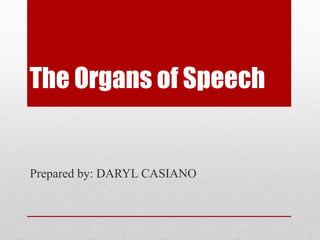
The Organs of Speech
- 1. The Organs of Speech Prepared by: DARYL CASIANO
- 2. -Jarod Kintz “If we spoke with our ears, and listened through our mouth, then a kiss might be the most romantic sound in the world.”
- 4. Objectives: At the end of the lesson, you are expected to: a) identify the organs of speech; b) use speech organs correctly; and c) improve vocal production.
- 5. Let’s talk about it The human mouth is comprised of several, equally important parts which we use for speaking and eating among others. However, this particular lesson will focus only on the parts which are critical to vocal production. When articulating sounds, you need to work with your lips, teeth, jaw, tongue, and facial muscles to properly produce the correct sound. Below is an illustration identifying some of the organs of speech.
- 6. The Organs of Speech
- 8. 1. Lips Technically termed as labio (singular), labia (plural). The two fleshy parts or folds forming the margins of the mouth
- 9. 2. Teeth Technically termed as dental. Hard bodies usually attached in a row to each jaw.
- 10. 3. Alveolar Ridge The ridge-like border of the upper and lower jaws. Contains the sockets of the teeth.
- 11. 4. Hard Palate The dome-shaped or the roof of the mouth.
- 12. 5. Soft Palate Technically termed as the velum. Separates the oral cavity from the nasal cavity.
- 13. 6. Nasal Cavity The space inside your nose.
- 14. 7. Pharynx The junction where the nasal and oral cavity meet. The space located around the walls of the throat and the root of the tongue.
- 16. 8. Tongue Technically termed as lingua. The usually movable organ in the floor of the mouth which has the dorsum (the back of the tongue), and its blades (sides of the tongue).
- 17. 9. Larynx The vocal production room (voice box) in which vocal cord is attached.
- 18. 10. Vocal cords The two flexible tough muscles that provide vibration during phonation.
- 19. 11. Glottis The opening of the vocal cords.
- 20. 12. Lungs The organs of gas exchange; blood flowing through the lungs picks up oxygen from inhaled air and releases carbon dioxide, which is exhaled. Air enters and leaves the lungs though the bronchial tubes.
- 21. • Speech organs or articulators, produce the sounds of language. • Organs used for speech include the lips, teeth, alveolar ridge, hard palate, velum (soft palate), uvula, glottis and various parts of the tongue. They can be divided into two types: passive articulators and active articulators. Active articulators move relative to passive articulators, which remain still, to produce various speech sounds, in particular manners of articulation. • The upper lip, teeth, alveolar ridge, hard palate, soft palate, uvula, and pharynx wall are passive articulators. The most important active articulator is the tongue as it is involved in the production of the majority of sounds. The lower lip is another active articulator. But glottis is not an active articulator because it is only a space between vocal folds.
- 23. Epiglottis lips Vocal folds Larynx Uvula Velum (soft palate) Hard palate Teeth Nostril Alveolar ridge
- 26. 1. TRUE OR FALSE. The soft palate serves to open and close the entrance to the nasal cavity. 2. TRUE OR FALSE. The space between the vocal folds is the epiglottis. 3. TRUE OR FALSE. The vocal cords are pressed together during voiceless consonants. 4. TRUE OR FALSE. When the air is made to move out of the lungs we say that there is a regressive pulmonic airstream. 5. TRUE OR FALSE. Articulatory phonetics studies different parts of the vocal tract.
- 27. 6. Which of the following is an active articulator? A. lower lip B. Alveolar ridge C. Hard palate D. Upper teeth
- 28. 7. Which part of the tongue forms the front wall of the pharynx? A. Tip B. Front C. Back D. Root
- 29. 8. Match the organs and their descriptions (5 points) 8.1. hard palate 8.2. vocal cords 8.3. larynx 8.4. Alveolar Ridge 8.5. Tongue A. The voice box B. The roof of the mouth C. Two thick flaps of muscle rather like a pair of lips D. This articulator can be moved into different places and different shapes E. The tongue can touch this to make a sounds like /t/ and /d/
- 30. 9. In the articulation of nasal sounds, the __________is lowered, and the air passes through the nose. A. Hard palate B. Tongue C. upper lip D. soft palate
- 31. 10.This articulator is called the voice box. A.Pharynx B.Palate C.Larynx D.tongue
- 32. LET’S CHECK YOUR PAPER
- 33. Answers 1. TRUE 2. FALSE 3. FALSE 4. TRUE 5. TRUE 6. A. LOWER LIPS 7. D. ROOT 8.1. B 8.2. C 8.3. A 8.4. E 8.5. D 9. D. SOFT PALATE 10. C. LARYNX
